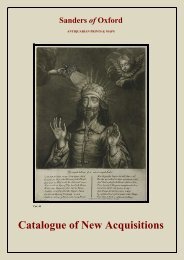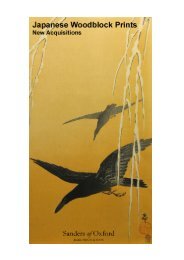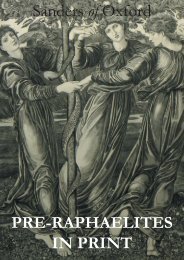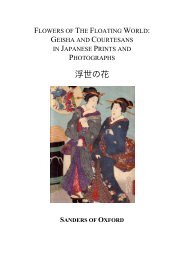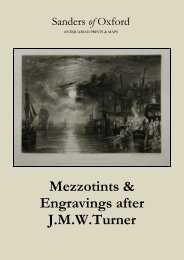catalogue text.indd - Sanders of Oxford
catalogue text.indd - Sanders of Oxford
catalogue text.indd - Sanders of Oxford
Create successful ePaper yourself
Turn your PDF publications into a flip-book with our unique Google optimized e-Paper software.
Biographies<br />
Artists<br />
Paul Brill (c.1553/4 - 1626) was a Flemish painter, draughtsman and etcher. Trained in Antwerp, Brill moved to Rome<br />
in around 1575, where he worked with his brother Matthijs and specialised in landscapes. He remained there for the<br />
rest <strong>of</strong> his life, and had a major influence on Italian landscape painting.<br />
Francis Philip Barraud (1824 - 1900) was an English watercolurist, etcher and painter <strong>of</strong> stained-glass windows. In<br />
1858, Barraud went into partnership with Nathaniel Wood Lavers in a company which produced stained-glass windows<br />
in the conventional Gothic Revival manner. Up until that point, Barraud had been a freelance designer and was<br />
renowned for his excellent draughtsmanship, which can be seen to manifest in his etching. In the 1880’s, Barraud<br />
produced the watercolours for a series <strong>of</strong> thirty chromolithographs <strong>of</strong> English cathedrals. He also exhibited with the<br />
Fine Arts Association in 1884.<br />
John Constable (1776 - 1837) was one <strong>of</strong> the most famed painters and watercolourists <strong>of</strong> the nineteenth-century. Born<br />
at East Bergholt, Suffolk, Constable was the son <strong>of</strong> a corn and coal merchant and farmer. Though he initially entered<br />
the family business in 1792, Constable made a sketching tour <strong>of</strong> Norfolk two years later, and upon an introduction to<br />
Joseph Farrington in 1799, was enrolled in the Royal Academy. He exhibited there from 1802; was made an Associate<br />
<strong>of</strong> the Royal Academy in 1819, and a Royal Academician in 1829. He was given the gold medal by Charles X when<br />
his work was displayed at the Paris Salon in 1824, and was awarded the same accolade two years later at the Society<br />
<strong>of</strong> Fine Arts, Lille. Between 1833, and until his death in 1837, Constable lectured on landscape painting at the Royal<br />
Institution, the Hampstead Literary and Scientific Society, and the Worcester Athenaeum.<br />
Isaac Robert Cruikshank (1789 - 1856) was a celebrated Scottish painter and caricaturist. Born in Edinburgh, it is<br />
widely believed that Cruikshank trained with John Kay, before travelleling with his master to London in 1783. Isaac<br />
Cruikshank was a contemporary <strong>of</strong> James Gillray and Thomas Rowlandson, and he was part <strong>of</strong> what has now been<br />
deemed ‘the Golden Age <strong>of</strong> British Caricature.’ Cruikshank had a pedagogical leaning. He is known to have given<br />
lessons in art, and George Dawe was a former pupil. His greatest success as a teacher however was arguably with his<br />
own sons, George and Robert, as they would grow to become two <strong>of</strong> the most important caricaturists <strong>of</strong> the nineteenth<br />
century.<br />
Albrecht Dürer (1471 - 1528) was a celebrated German polymath. Though primarily a painter, printmaker and graphic<br />
artist, he was also a writer, mathematician and theoretician. Born in Nuremberg, Dürer was apprenticed to the painter<br />
Michel Wolgemut whose workshop produced woodcut illustrations for major books and publications. He travelled<br />
widely between the years <strong>of</strong> 1492 and 1494, and is known to have visited Martin Schongauer, the leading German<br />
painter and engraver at the time, at his studio in Colmar. In 1495, Dürer set up his own workshop in his native Nuremberg,<br />
and, by the beginning <strong>of</strong> the sixteenth-century, had already published three <strong>of</strong> his most famous series’ <strong>of</strong> woodcuts:<br />
The Apocalypse; The Large Passion, and The Life <strong>of</strong> the Virgin. Nuremberg was something <strong>of</strong> a hub for Humanism<br />
at this time, and Dürer was privy to the teachings <strong>of</strong> Philipp Melanchthon, Willibald Pirkheimer and Desiderius<br />
Erasmus. The latter went so far as to call Dürer ‘the Apelles <strong>of</strong> black lines’, a reference to the most famous, ancient<br />
Greek artist. Though Dürer’s approach to Protestantism was not as staunch as that <strong>of</strong> his fraternity, his artwork was<br />
just as revolutionary. For their technical virtuosity, intellectual scope, and psychological depth, Dürer’s works were<br />
unmatched by earlier printed work, and, arguably, have yet to be equalled.<br />
Joseph Farington (1747 - 1821) was an English landscape painter and topographical draughtsman. From 1763 he<br />
was a pupil <strong>of</strong> Richard Wilson, whom he assisted until 1767/8. He entered the Royal Academy schools in 1769, and<br />
exhibited there between 1778 and 1813. He became a Royal Academy member in 1785. His Diary 1793-1821 is a key<br />
source <strong>of</strong> information about the London art world.<br />
William Hincks (1752 - 1797) was an Irish painter <strong>of</strong> portraits; he was also a miniaturist and an engraver. He was born<br />
in Waterford but moved to London in 1780 before subsequently enrolling in the schools <strong>of</strong> the Royal Academy.<br />
Thomas Hulley (fl. 1798 - 1817) was a British watercolourist and aquatinter. He is best-known for his topographical<br />
works featuring mountains and rivers.<br />
Hulley is believed to have lectured in the painting <strong>of</strong> oils and body colours, as well as the practise <strong>of</strong> tinted drawings,<br />
in the city <strong>of</strong> Bath.





